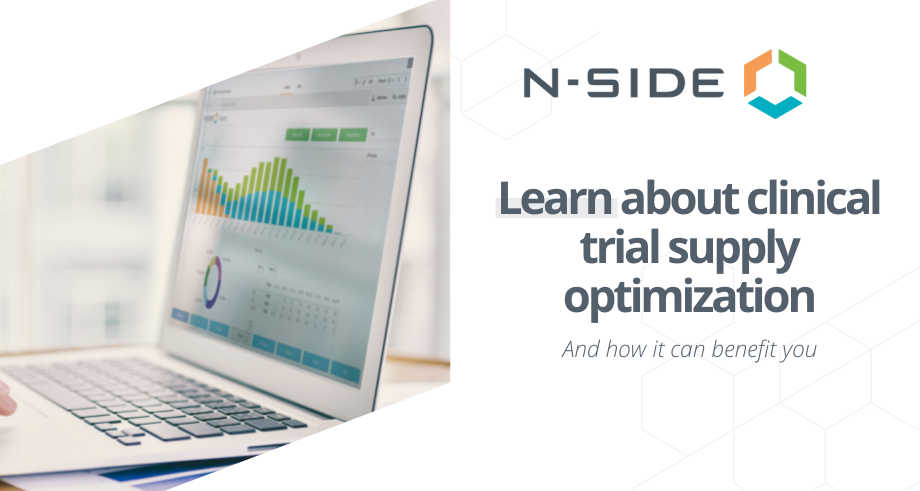What is clinical trial supply optimization?


Clinical trial supply optimization is the process of supplying the right amount of investigational medicinal product (IMP) and comparators to all trial sites so all patients receive their doses on schedule.
By optimizing the clinical trial supply strategy, all sites can be safely supplied while minimizing both costs and drug waste. This is accomplished by calculating drug product overage as an output of optimization models.
This way, clinical trial supply managers can avoid the high costs of having too much overage, as well as the unacceptable risks of having too little.
Clinical trial supply optimization is difficult, requiring complex mathematical models and reliable data. Luckily, advanced analytics and new software tools are making clinical trial supply optimization easier and more accessible.
When should you optimize clinical trial supply?
The optimization process occurs during several stages in the clinical trial lifecycle:
Protocol design
Clinical trial supply optimization can begin as soon as the project concept is complete. Six months or more prior to the first patient enrollment, optimization solutions can be used to run simulations that will inform protocol design.
While it may seem odd to begin optimization when there are so many unknowns, it’s important to remember that the goal is to proactively manage risk. Many decisions made at this stage can increase waste and risk of missed dispensing. These decisions may include:
- Country list
- Intervals between different events in the trial
- Packaging design
- Distribution network design
- Home delivery of medication
Conducting optimization at this stage will result in a supply-friendly protocol that minimizes stress, risk, costs, and timelines.
Close collaboration with the Clinical Operations team is important during protocol design to ensure that patient and site centricity of the trial are maintained.
Prior to study start
Just before the study begins, optimization solutions can be used to ensure trial logistics decisions (e.g. packaging and sourcing campaigns, depot resupply strategy, IRT configuration) don’t inadvertently increase drug waste or risk of missed dispensing.
In order to optimize these decisions, trial supply managers need access to reliable forecasts for factors such as:
- Inventories
- Shipments
- Recruitment timing and location
- Screening failure
- Factors impacting patient demand (e.g. drop-out, dose levels/titrations, BSA, weight ranges)
It is also important to be aware of any constraints and limitations, such as country-specific regulations, stock limitations, and manufacturing constraints. All of these factors should be considered in order to build a robust strategy that offers the lowest possible levels of risk and drug waste.
After study start
Clinical trial supply optimization doesn’t stop when the trial begins. Because clinical trials are unpredictable, it’s important that trial data is monitored to ensure the supply strategy remains optimized and that any required adjustments are made proactively.
Factors that may inform supply optimization during an ongoing trial include:
- Recruitment
- Drop-outs
- Titrations
- Patient weight
Why optimize clinical trial supply?
Clinical trial supply optimization is about achieving an efficient supply chain that safely enables more ambitious clinical plans.
In the past, the pharmaceutical industry tolerated non-optimal supply strategies that resulted in large amounts of drug waste. However, as new types of therapies drastically increase the costs and challenges of manufacturing IMPs and acquiring comparators, it’s no longer acceptable to require such large buffers to guard against risks in the supply chain.
Now, using advanced analytics, clinical trial supply teams can:
Reduce costs
One obvious benefit of reducing required overage is cost reduction. However, you may be surprised to learn just how much money clinical trial supply optimization can save.
Users of the N-SIDE Supply App, a clinical trial supply optimization solution, typically experience 20-50% overall cost savings and 20-40% cost reduction related to comparator sourcing.
With the costs of clinical trials rising, these savings can add up to millions or even billions of dollars across a clinical trial program.
Reduce trial timelines
An optimized trial requires much less IMP and comparator than a non-optimized trial. That’s important because manufacturing lead times and constraints on comparator sourcing are two major factors that extend trial timelines.
When accelerating time to market is a top priority, optimizing clinical trial supply is necessary. By reducing the required amounts of comparators and IMP, timelines can be drastically reduced.
In addition, reducing required overages enables pharma companies to run more trials concurrently using the same amount of resources.
Ensure 100% patient service level
Most importantly, optimizing clinical trial supply ensures all trial sites are supplied safely — meaning that every patient gets every dose on schedule.
This is accomplished by using advanced analytics to pinpoint when and where risk could occur in the supply chain. Once risks have been accurately identified, the trial supply strategy can be designed to ensure there is no risk that can’t be proactively mitigated.
Then, as the trial unfolds, key metrics are continuously monitored and clinical trial supply teams are alerted well in advance of any risk of missed dispensing, so they can adjust their plan accordingly.
This can help eliminate the constant firefighting associated with clinical trial supply and dramatically reduce stress for managers.
How can I optimize clinical trial supply?
Effectively optimizing clinical trial supply requires advanced mathematical analyses such as Monte Carlo simulations, as well as artificial intelligence techniques like machine learning.
Software is now available that makes these techniques accessible for pharmaceutical companies. One software solution for optimizing clinical trial supply is the N-SIDE Supply App.
The N-SIDE Supply App provides risk-based optimization, accounting for many more factors than competing solutions in order to provide more accurate forecasts and a clearer picture of risk in the supply chain.
With powerful models and interactive dashboards, the Supply App helps clinical trial supply managers proactively mitigate risk at all stages of a trial.
Learn more about the N-SIDE Supply App
Various other service providers will also offer supply optimization solutions. In order to identify the best solution for your needs, ensure it can:
- Account for the wide variety of factors that impact trial demand, including:
- Protocol design
- Recruitment speed and cohorts
- The flexibility of the IRT/RTSM algorithm
- Drug shelf life and expiry replacements
- Dose titrations
- Distribution network and label groups
- Provide minimum and maximum forecasted demand boundaries for safely supplying a trial without risk (rather than simply forecasting average demand).
- Optimize supply strategy during an ongoing trial, ideally using machine learning to interpret real-time conditions.
- Provide data visualization and interactive dashboards to maximize usefulness and enhance collaboration.
Case study: Being prepared for all outcomes
CSL Behring engaged N-SIDE to help optimize supply for a high-stakes clinical trial. Using the N-SIDE Supply App, the team was able to simulate many different what-if scenarios and pinpoint potential risks in the supply chain.
As the trial got underway, CSL Behring experienced higher-than-expected enrollment and lower-than-expected manufacturing yields, but was able to proactively respond to these scenarios thanks to their optimized supply strategy.
They also used the Supply App to continuously monitor the trial and react quickly to ensure sufficient inventory.
Learn more about risk-based optimization and the limits of clinical trial forecasting:




